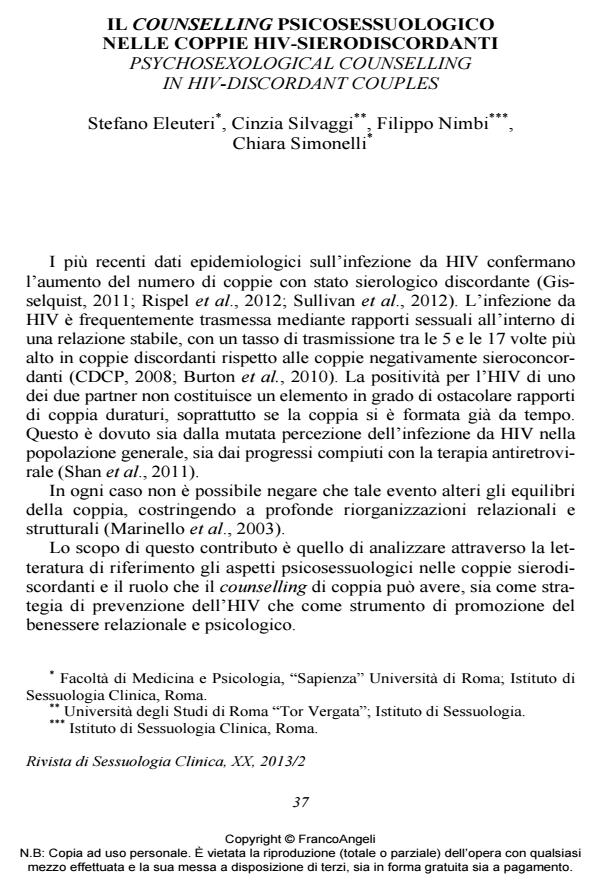Il counselling psicosessuologico nelle coppie hiv-
Titolo Rivista RIVISTA DI SESSUOLOGIA CLINICA
Autori/Curatori Stefano Eleuteri, Cinzia Silvaggi, Filippo Nimbi, Chiara Simonelli
Anno di pubblicazione 2013 Fascicolo 2013/2
Lingua Italiano Numero pagine 18 P. 37-54 Dimensione file 380 KB
DOI 10.3280/RSC2013-002002
Il DOI è il codice a barre della proprietà intellettuale: per saperne di più
clicca qui
Qui sotto puoi vedere in anteprima la prima pagina di questo articolo.
Se questo articolo ti interessa, lo puoi acquistare (e scaricare in formato pdf) seguendo le facili indicazioni per acquistare il download credit. Acquista Download Credits per scaricare questo Articolo in formato PDF

FrancoAngeli è membro della Publishers International Linking Association, Inc (PILA)associazione indipendente e non profit per facilitare (attraverso i servizi tecnologici implementati da CrossRef.org) l’accesso degli studiosi ai contenuti digitali nelle pubblicazioni professionali e scientifiche
I più recenti dati epidemiologici sull’infezione da HIV confermano l’aumento del numero di coppie con stato sierologico discordante. Dal punto di vista psicosociale ci sono molti fattori che possono destabilizzare o rompere l’equilibrio della coppia: difficoltà ad affrontare argomenti legati alla sfera sessuale, preoccupazioni circa l’intimità, smarrimento, paura, sensi di colpa o di responsabilità, inadeguatezza, esclusione, incomunicabilità e fallimento. Questi ostacoli possono necessitare di un supporto psicologico "di coppia", soprattutto nel momento della scoperta dell’infezione, per sviluppare strategie relazionali utili. Lo scopo di questo contributo è quello di analizzare attraverso la letteratura di riferimento gli aspetti psicosessuologici nelle coppie sierodiscordanti e il ruolo che il counselling di coppia può avere, sia come strategia di prevenzione dell’HIV che come strumento di promozione del benessere relazionale e psicologico.
Parole chiave:HIV, coppie sierodiscordanti, counselling psicosessuologico, approccio integrato, comportamenti sessuali a rischio, salute sessuale.
Stefano Eleuteri, Cinzia Silvaggi, Filippo Nimbi, Chiara Simonelli, Il counselling psicosessuologico nelle coppie hiv- in "RIVISTA DI SESSUOLOGIA CLINICA" 2/2013, pp 37-54, DOI: 10.3280/RSC2013-002002